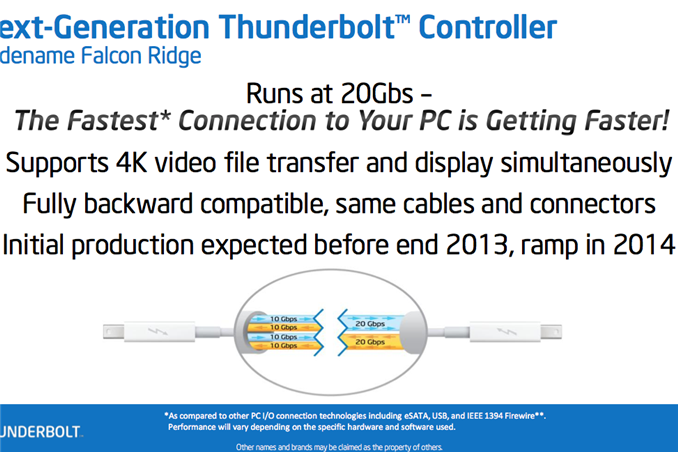Intel Confirms Falcon Ridge Production in 2013, Ramp in 2014
by Anand Lal Shimpi on April 9, 2013 1:51 PM EST- Posted in
- Storage
- CPUs
- Intel
- Thunderbolt

Yesterday Intel announced its updated Redwood Ridge Thunderbolt controllers (adding 4K/DP1.2 support, lower power operation and slightly lower BOM cost) as well as next year's Falcon Ridge family of Thunderbolt controllers. I assumed that Falcon Ridge would ship alongside Broadwell in late 2014 but I just got word that the new Thunderbolt controllers will begin production by the end of this year and ramp volume through 2014. I don't have more specific dates than that, but it's still good news.
All Intel is saying about Falcon Ridge is the spec includes a speed bump to 20Gbps per lane up from the current controllers with 10Gbps per lane. Intel's own presentation refers to a single channel/two lane Falcon Ridge controller, delivering no additional bandwidth above existing TB implementations (although there may be practical advantages since you can't easily aggregate all TB channels today). I would assume that we'd see even higher bandwidth implementations but Intel isn't talking about any of that today.










31 Comments
View All Comments
repoman27 - Tuesday, April 9, 2013 - link
You are right, comrade. We should only concern ourselves with technologies that are provided to all at no additional cost and that are capable of operating within the most meager power of power budgets.Then again, even Volkswagen produced the Phaeton.
Anywho, a bit of a bummer that Falcon Ridge appears to be Redwood Ridge with channel bonding, but I guess it makes sense. I'm also a little concerned after watching the video of Intel's Falcon Ridge demo that the PCIe back end is still 2.0 x4, seeing as 2 SSD's capable of 1 GB/s each only hit 1259.87 MB/s combined.
p_giguere1 - Tuesday, April 9, 2013 - link
Why would it come standard on your average cheap laptop when it only targets a niche market? Consumer products like external hard drives can't even saturate USB 3.0. Thunderbolt displays, arrays and external SSDs are too expensive to target most consumers.Should something not exist only because not 100% of people use it?
I don't understand your logic, I basically just read that as "I won't use it so I don't care".
GNUminex - Wednesday, April 10, 2013 - link
Not even high end mobile computers can be obtained with thunderbolt save one Vaio and Apple's laptops. With hardware like the apple monitor or sony's apparently short lived TB dock, you only have to plug in one cable to connect to all of your peripherals, and you can have expandability options not traditionally available in laptops. In the not too distant future ultrabooks are going to be fast enough but we will still be stuck with two usb ports and a minihdmi port and plugging in peripherals when using the computer at desk is going to be a pain.Tams80 - Sunday, April 14, 2013 - link
Docking.It's useful for using several devices through one port, so that port can be saturated. It's also better for EGPUs, as ExpressCard does get saturated and is being used less and less by manufacturers, not to mention being somewhat clumsy when used for EGPUs.
My worry is that manufacturers will go "Oh, you only need one or two ports now. You can just dock using the Thunderbolt port" and in the process forgetting that while mobile that is less practical than having multiple ports. That's providing Thunderbolt doesn't go the way of Firewire.
CSMR - Tuesday, April 9, 2013 - link
Who cares? Displayport is the modern standard for computer video, and USB3 & firewire for data. This is no better than these standards and just adds extra connectors, extra processing, and incompatibility. Displayport can already do 4k at 60hz and 30bpp not that anyone uses it.A5 - Tuesday, April 9, 2013 - link
1) Firewire isn't standard for anything. Even Apple doesn't have FW ports anymore.2) You have a basic misunderstanding of what TB is for if you think it's competing with USB 3.0.
p_giguere1 - Tuesday, April 9, 2013 - link
Extra connectors and incompatibility?Are you aware that Thunderbolt uses a mini DiplayPort connector and is retrocompatible with it? It's basically just a mDP port that happens to transfer data really fast (if you want to). You can also still use it strictly for video outside without any downside if you wish.
p_giguere1 - Tuesday, April 9, 2013 - link
*video outputCSMR - Friday, April 12, 2013 - link
I did not realize it uses a displayport connector. That will confuse users who will connect thunderbolt devices to displayport outputs. So using it as displayport brings no disadvantages? But you have an extra chip in the computer, adding cost and space and increasing power consumption, and an extra source of unreliability.A separate external PCI express connector and interface would have been a better idea than combining two very different connections with different protocols into one.
erple2 - Friday, April 12, 2013 - link
It doesn't matter if you plug in a monitor to a tb port on a Mac. The hardware figures it out and does the right thing. It's a pretty nice solution from apple. I think that is the right way to implement it - the connector figures out what you've plugged in, mini display port or thunderbolt peripheral and acts accordingly. It probably adds a little bit of cost, but it is apple you're talking about, so...